|
Encounter Timeline
The encounter of the STARDUST spacecraft with
Wild 2 spans a period 50 days before to 50 days
after the actual fly-by of the comet. This is
divided into five time periods during which various
mission activities are planned.
- Far Encounter: E-50
to E-1 days
- Near Encounter: E-1
d to E-5 hr
- Close Encounter: E-5
hr to E+5 hr
- Closest Encounter:
E-360 sec to E+360 sec
- Post Encounter: E-0
d to E+50 days
|
Encounter Requirements
Science
- Collect Dust Particles
- Images
- Closest Encounter
- Transmit Real Time One Image
as Near as Possible to Nucleus
- Image Size is 150x150 pixels
- CIDA and DFMI - Store
Science Data
- Dynamics Science -
Analyze Engineering and Doppler Data
Navigation
- Far Encounter
OPNAV begins at E-50 days.
- E-50 to E-30 Days
- Two OPNAV opportunities per
week
- E-30 to E-10 Days
- One OPNAV opportunity per day
- E-10 to E-3 Day
- Three OPNAV opportunities per
day
- E-3 Days to E-12 Hours
- One OPNAV opportunity per hour.
- Provide Sufficient
Tracking Coverage to Support the Design
of TCMs
- OPNAV opportunity defined
as: 25 windowed frames of various exposures
except after E-3 days, where it is then
reduced to 4 windowed frames.
Spacecraft
- Deploy the Aerogel
Collector 9 Days Prior to Close Encounter
- Perform a Roll About
the X-Axis to Maintain Nav Camera Field
of View (Pre and Post)
- Command the Mirror
to Maintain the Comet Nucleus Within the
Nav Camera Field of View
|
Navigation Plan
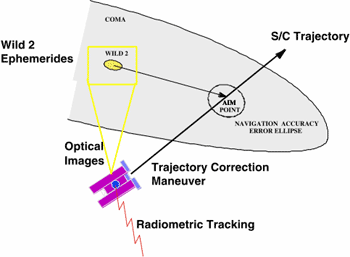
Encounter Geometry
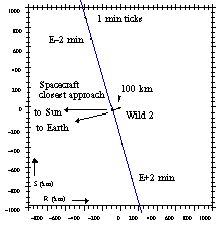
The spacecraft will encounter Wild 2 at 98.5
days past perihelion at 1.86 AU from the Sun when
Wild 2 is far from its peak active period and
relatively safe for a close flyby. The spacecraft
will approach Wild 2 from slightly above its orbital
plane.
Orbital Geometry at Closest Encounter, where RS
is the orbital plane, R=radial direction, Sun
to Wild 2, S=orthogonal to R along Wild 2 velocity
direction.
Encounter Phase Sequence
of Events
- L+1691 to L+1841 (E-100
to E+50 Days)
- Exiting Longest Solar Conjunction
(~60 Days) at Start
- 6 TCMs
- Optical Navigation
- One OPNAV opportunity per day
- Deploy Aerogel Collector
- CIDA Power During Entire Phase
- DFMI Power for 30 minutes around
closest approach
- Encounter Training Excerises and
Readiness Review
- Sub-Phases
- Pre-Far Encounter
- NAVCAM calibration imaging:
geometric and photometric
- Far Encounter
- Near Encounter
- Close Encounter
- Closest Encounter
- Post Encounter
|
Far Encounter
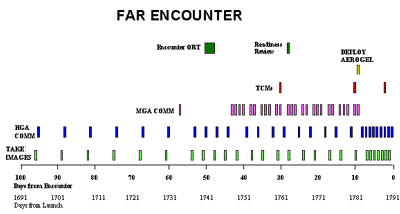
Far Encounter Details
(E-50 to E-1 days)
- Nominal Attitude +Z
to Sun ±15° Deadband
- Image Attitude Deadband
is ±0.25°
- Deploy Aerogel ~9 Days
Before Encounter
- HGA Communications
- Downlink Allocation is 50% Images
/ 50% Other
- 25% for Stored Engineering Telemetry
and CIDA/DFMI Science Data
- 25% for Real Time Engineering
Telemetry
- 50% for Images
- Data Rate is 504 BPS (DSN 34 Meter
Antenna)
- At E-3 Days Use DSN 70 Meter Antenna
(15,800 BPS)
- Data
- Images (Science, OPNAV)
- 8 Bit/Pixel Images
- Windowed and Compressed to Fit
Bandwidth
- CIDA Available for Data Collection
|
Far Encounter Subphase
(E-50 d to E-1 d)
OPNAV will begin at about E-50 d when Wild 2 becomes
detectable. The coma will be the focus of the
imaging science during this period. Coma images
acquired during this period will have resolutions
of 32 to 1000 km per pixel. At E-1 d, the coma
image begins to fill the FOV of the camera, and
the focus of the imaging will be on the finer
details.
Near Encounter
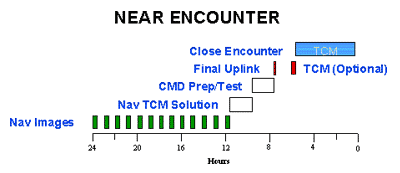
- Navigation Images are
8 Bits/Pixel (Windowed and Uncompressed)
- Attitude Deadband is
±0.25° (Imaging and communications)
- Continuous Communications
Using HGA and DSN 70 Meter Antenna
- Telemetry Data Rate
is 15,800 BPS
- Close Encounter Block
Loaded at E-24 Hours
- CIDA Available for
Data Collection
- Final Uplink Contains
TCM and Updated Close Encounter Timing
- After TCM, ACS is in
Encounter Mode (±0.3°, 1lb
Thrusters Enabled)
|
Near Encounter Subphase
(E-1 d to E-5 hr)
STARDUST enters the terminal navigation phase
with increased OPNAV activities. Continuous communication
with Earth (70-m stations) will be established.
At E-3 d the OPNAV picture rate will be increased
to one per hour. All data acquired since the previous
TCM (E-2 d) will be processed on the ground as
each image is received for image location extraction,
orbit determination, and the final TCM computation.
We expect to obtain finer details of the coma
when we image Wild 2 during this period. The Wild
2 nucleus will still be a pinpoint until the end
of this phase when it begins to occupy about a
pixel. Images of Wild 2 with resolutions ranging
from 6.5 to 32 km per pixel will be obtained during
this period.
Close Encounter
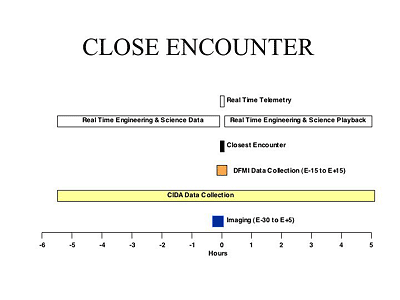
Close Encounter Details
- Data Rate is 15,800
BPS (DSN 70 Meter Antenna)
- Science
- Images
- Images are Hardware Compressed
(8 Bits/Pixel)
- Flexible Number of Image Sets
Prior to Centroiding
- All Images Prior to Centroiding
Are Downlinked, Not Stored On-Board
- CIDA and DFMI Data is Stored and
Downlinked as Bandwidth is Available
- Dust Collection Happens
- Centroiding Starts
at E-30 Minutes
- Image Every 10 Seconds
- Flight Software Calculates Projected
Mirror Position and Commands
- New Mirror Profile at E-10 Minutes
- Centroiding Ends at E+8 Minutes
|
Close Encounter Subphase
(E-5 hr to E+5 hr)
This is the core science period of the mission.
At E-5 hr the spacecraft will begin to enter the
coma (100,000 km from Wild 2) and the nucleus
will start to emerge as an extended body in the
camera FOV. All comet science will be on with
exception of the DFMI at -15 minutes. Continuous
tracking of the spacecraft with the 70-m station
is planned until the end of this mission subphase.
Dust collection will have been enabled with the
deployment of the dust collector at E-9 days.
The spacecraft dust shield and the collector array
will orient perpendicular to the dust stream (spacecraft-comet
relative velocity) to protect the spacecraft from
the dust hazard while maximizing the collection
area. CIDA will provide information on comet particle
composition during the fly-through. Data from
up to 10,000 CIDA events will be compressed and
stored on board. The data volume allocated is
about 200 Mbits. Imaging and real-time transmission
of data will be made from E-5 hr to E-6 min. At
E-6 min, a final black and white picture surrounding
the nucleus will be sent in real time. Any images
taken after E-6 min will be stored on board. Figure
8 shows details of mission activities occurring
from E-6 min to E+6 min. Due to the uncertainty
in delivery, the image of the nucleus may spill
out of the FOV of the camera beginning at about
E-2 min. Although the scanning mirror can compensate
for down-track and in-plane errors, only banking
the spacecraft (by providing the second axis to
the mirror) can correct out-of-plane errors. Because
of this, temporary loss of high-gain lock to Earth
during the ±6 min of the encounter is expected.
The medium gain antenna will take over the critical
communications function during this time.
Figure 8. Timeline During Closest Encounter,
E-6 min to E+6 min
Closest Encounter
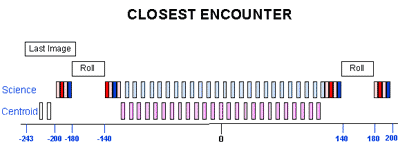
- Images Are 8 Bits/Pixel
- 72 Images Stored In
Memory
- No Images Taken During
Roll
- CIDA and DFMI Data
is Stored
|
Post Encounter
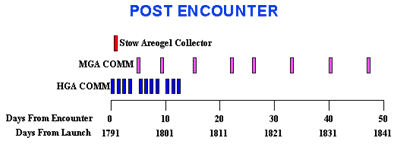
- Stow Aerogel Collector
- Transmit Science Data
- Image Data
- 600 MBits of Image Data
- Approximately 30 Hours at 15,800
BPS using HGA
- CIDA Data
- DFMI Data
|
Post-Encounter Subphase
(E+5 hr to E+50 d)
Post-encounter spacecraft health check, reconstruction
of flyby conditions and downlink of recorded data
will constitute the activities of this mission
phase. DSN tracking similar to cruise-phase mode
will resume.
Appendix
+
Acronyms
|
